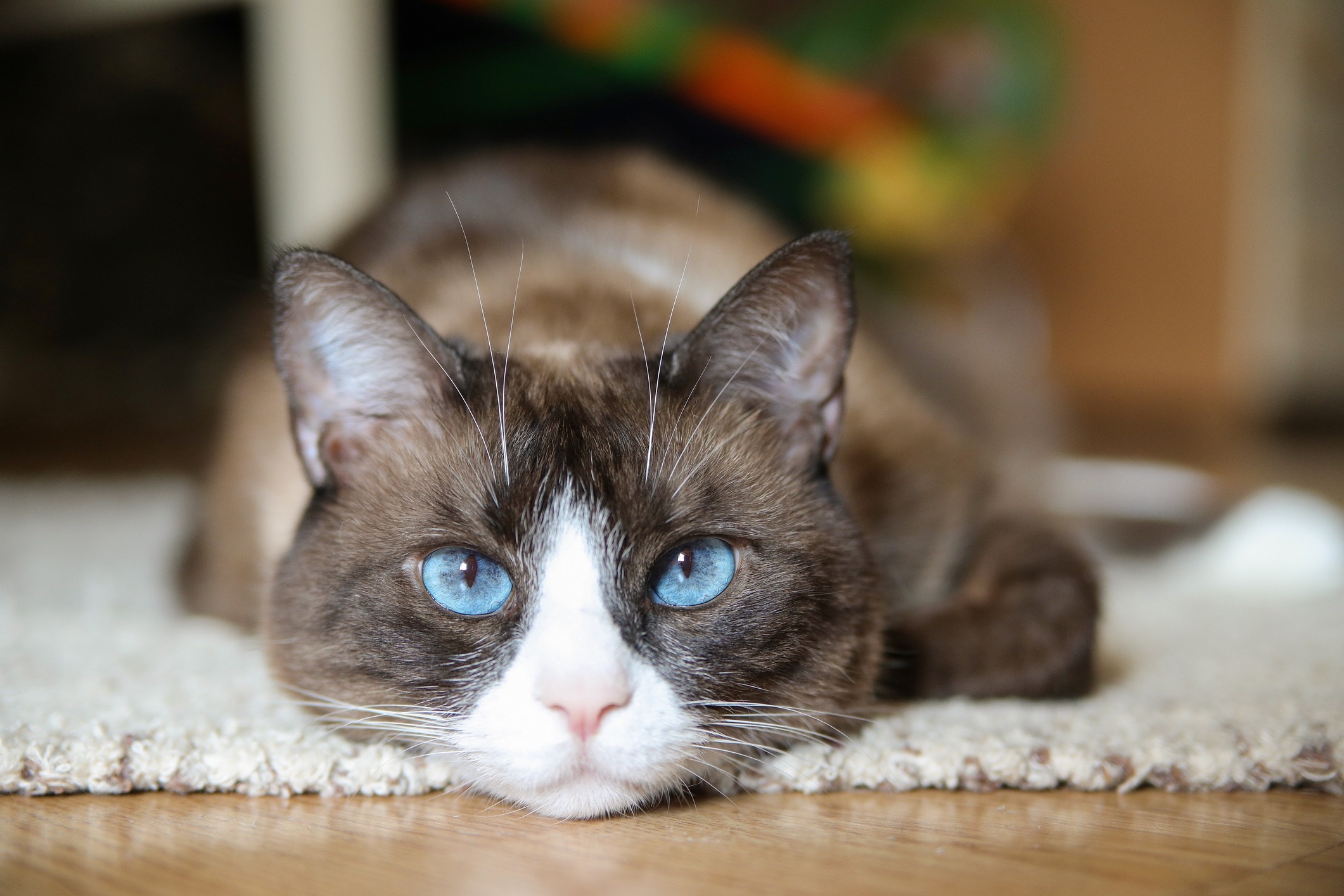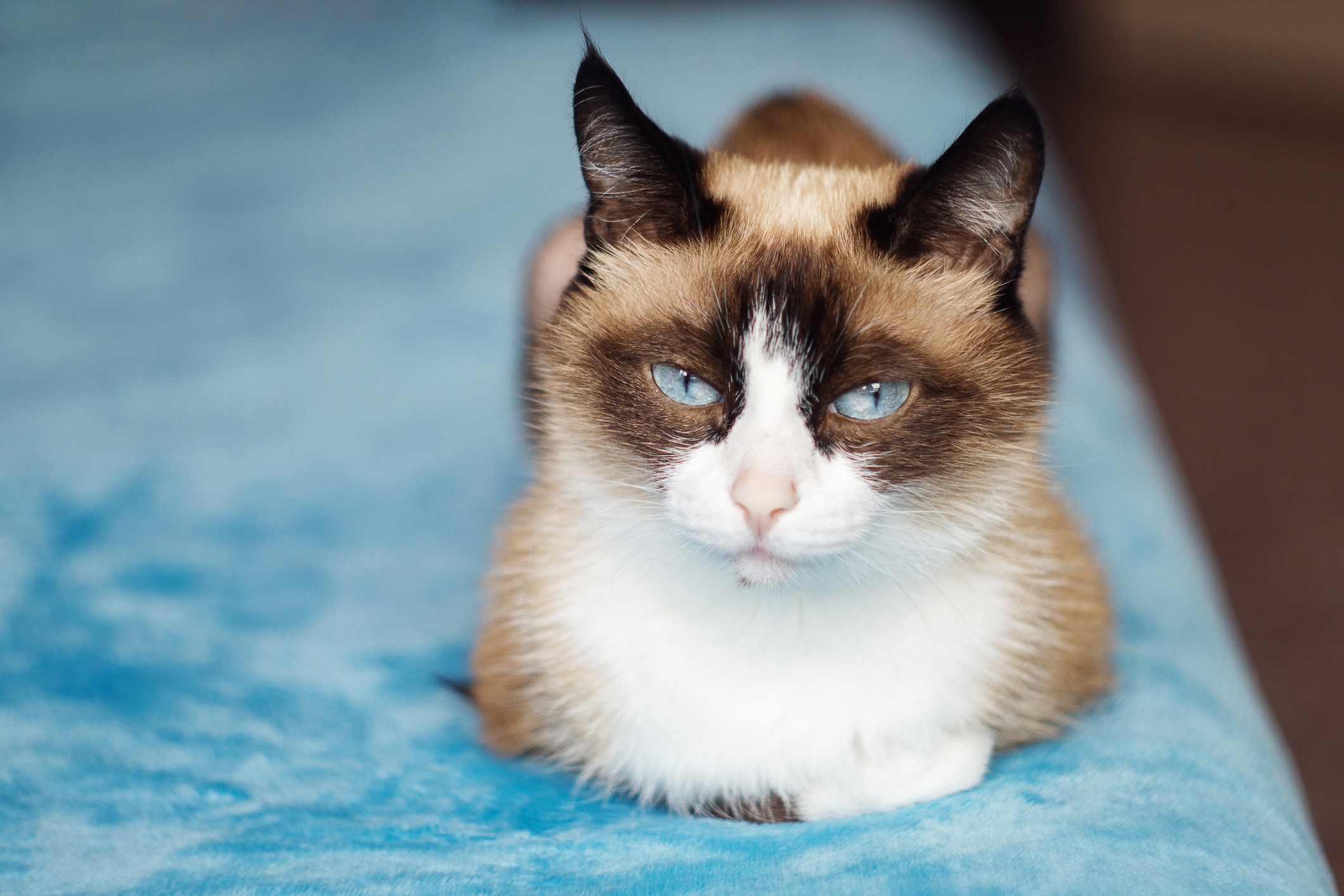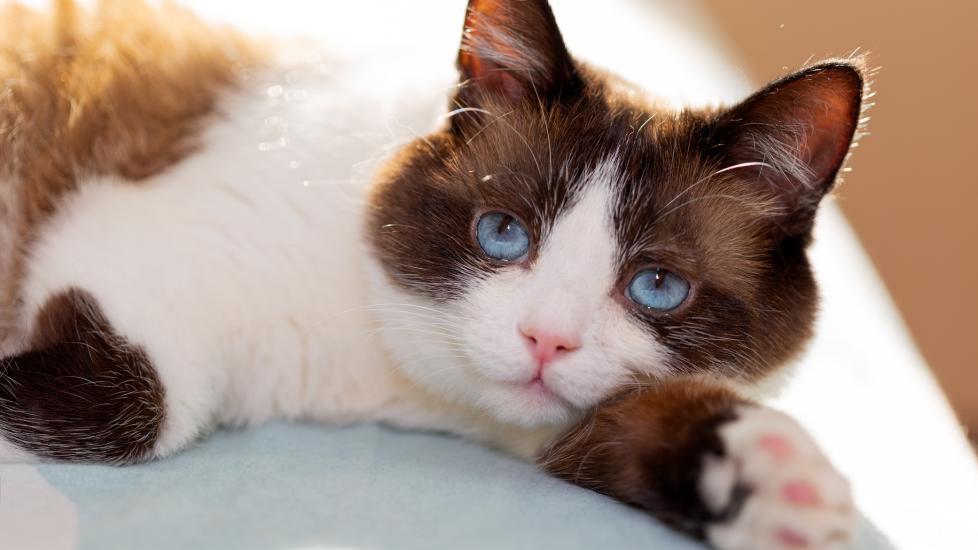Snowshoe Cat
True to their charming name, the sociable Snowshoe cat flaunts mittened paws or “boots” adorned with snow-white fur. The white can just be on the tip of their toes or extend up the leg. The Snowshoe cat’s personality is a delightful mix, drawing from the spirited nature of the Siamese and the playful, yet slightly more docile, demeanor of the American Shorthair, from which the breed is descended.
Snowshoe cats are medium to medium-large cats, weighing 7–14 pounds and measuring 8–13 inches at the shoulder. The Goldilocks of cats, “they are neither too small nor too large,” according to the Snowshoe Cat Society.
Caring for a Snowshoe Cat
Whether they inherit a love of conversation from their Siamese parent or a touch of laid-back charm from their American Shorthair half, you can expect your Snowshoe to cherish connecting with others. Their social nature, playful spirit, and adaptability make them ideal companions for just about anyone, including other pets, children, and seniors.
While many Snowshoe cats enjoy cuddle sessions, they shouldn’t be mistaken for a lap cat content to nap the day away. To keep your Snowshoe happy and discourage unwanted behaviors like climbing and scratching furniture, provide them with cat trees, scratching posts, and interactive toys. Like most cats, they benefit from about four 10-minute sessions of interactive playtime a day.
Shop for Your Breed
Snowshoe Cat Health Issues

Inheriting the long life of their parent breeds, a Snowshoe cat’s lifespan is 14–20 years. However, all cats are at risk of serious medical conditions, illnesses, and even accidents throughout their lives. Considering pet insurance for your Snowshoe kitten might be worthwhile.
Some conditions that Snowshoe cats may be prone to include:
Pica
According to a study published in the Journal of Veterinary Behavior, pica isn’t uncommon in Oriental cat breeds like Siamese, so the condition might pop up in Snowshoes as well.
Pica in cats is the tendency to eat non-food items, with wool-sucking being one of the most prevalent forms of this compulsive behavior. Pica can pose danger, as ingesting non-food items like certain houseplants, hair ties, and string may lead to poisoning or internal obstructions.
If you notice your Snowshoe cat eating things they shouldn’t, talk with your veterinarian.
Hypertrophic Cardiomyopathy (HCM)
Hypertrophic cardiomyopathy (HCM) is the most prevalent form of heart disease in cats and is more common in some breeds than others, including the American Shorthair. HCM is characterized by the thickening of the heart walls, impeding its ability to pump blood.
Genetic testing for HCM is available for certain cat breeds, including the Maine Coon and Ragdoll. Unfortunately, it has not yet been developed for Snowshoe cats. Because genetic testing isn't an option for this breed, regular cardiac exams are crucial for detecting HCM early. This is especially important for breeding cats, as screening ensures they don't pass the condition to their kittens. Cats diagnosed with HCM should not be bred.
Early stages of HCM often go unnoticed, making routine checkups even more important, as a vet can detect a heart murmur (which is common with HCM) during an exam. However, as the disease progresses, some common signs and symptoms of HCM to watch for include:
What To Feed a Snowshoe Cat
Your veterinarian is your best resource for selecting cat food that best suits your feline companion. However, a good starting point is choosing a commercial cat food that meets the nutritional standards set by the Association of American Feed Control Officials (AAFCO) for your cat's life stage.
How To Feed a Snowshoe Cat
Cats are natural-born hunters and may prefer eating two or more small meals throughout the day. To fully engage their hunting instincts, consider incorporating foraging mats or food puzzles during meal or snack times.
How Much To Feed a Snowshoe Cat
Even active cats such as the Snowshoe can become overweight or obese if overfed. Because every food has a different caloric value and every cat has varying nutritional needs, there's no one-size-fits-all feeding amount.
Begin by following the feeding guidelines on the back of the bag that provide a feeding estimate based on your cat's current weight. However, the most accurate way to determine your cat's ideal meal size is by taking into account their current weight, ideal weight, lifestyle, and age. Your veterinarian can help you determine the right calorie intake based on these factors.
Nutritional Tips for Snowshoe Cats
A complete and balanced meal that meets AAFCO’s statement of nutritional adequacy provides young cats in good health with all the essential nutrients, vitamins, fats, and proteins they need. Your veterinarian may recommend special diets or supplements as your cat ages, or if they develop any health conditions.
Cats are generally considered senior around 10 years old. When your cat reaches this milestone, it's a good time to consult your vet about transitioning your cat to a senior diet. Because older cats are prone to arthritis, senior cat food often incorporates joint-healthy supplements, such as omega-3 fatty acids from fish oil.
Behavior and Training Tips for Snowshoe Cats
Snowshoe Cat Personality and Temperament

Snowshoe cats can be quite adaptable, making them excellent companions for busy households—including those with other pets or children. That said, a cat’s adaptability relies heavily on early socialization, proper introductions, and teaching kids how to handle and care for pets appropriately.
Experts emphasize that while genetics play a role in shaping a cat's personality and temperament, early experiences and interactions are just as important.
Snowshoe Cat Behavior
American Shorthairs are known for being playful, laid-back, and social, while Siamese cats are characterized as spunky and talkative. It’s hard to say what mix of behaviors and traits your Snowshoes will exhibit, but there’s a good chance they’ll be an active cat that enjoys social interaction.
To satisfy their playful and spunky side, provide your cat plenty of opportunities to play, exercise, and explore. You’ll help deter unwanted behaviors like excessive vocalization and scratching the furniture.
Snowshoe Cat Training
A Snowshoe’s high intelligence, high energy, and love of their human companions make training a fun activity. They’re athletic, and also quickly catch on to fun games such as fetch or jumping to marker spots.
Fun Activities for Snowshoe Cats
-
Being around people and other pets
-
Watching and chirping at birds
-
Fetching toy mice
-
Climbing cat trees
-
Exploring new spaces
-
Solving feeder puzzles
-
Cuddling
Snowshoe Cat Grooming Guide
When it comes to coat appearance, Snowshoes take after their Siamese ancestors. They have short (rather than fluffy) fur with color points, meaning they have dark “points” on their tail, face, and ears that contrast with their light body and white feet.
Black, brown, cinnamon, and beige are common point colors, but you might even spot a lilac Snowshoe cat (a pale, grayish-purple fur color that is a dilution of the chocolate gene). You’ll also recognize Snowshoes by the upside-down “V” from their forehead to their muzzle. Their eyes are always a dazzling blue.
Skin Care
If you notice your cat is overgrooming, itchy, or has skin irritation, schedule a checkup with your veterinarian. Otherwise, Snowshoes don’t require special skin care or bathing.
Coat Care
Snowshoe cats have a short, single-layer coat that doesn't shed excessively. Even so, it’s a good idea to brush your cat weekly.
Eye Care
Your Snowshoe cat might inherit crossed eyes from their Siamese parent, but it shouldn't impact their vision. However, redness of the eyes, abnormal discharge, or irritation could indicate a feline eye infection.
Consult your vet for proper care, as they can treat the infection with antibiotics.
Ear Care
Check your cat’s ears for dark specks that look like coffee grounds (mites) or a foul smell from the ears. If you notice anything unusual, call your veterinarian.
Considerations for Pet Parents

Every cat is unique in personality and temperament, regardless of breed. That said, when bringing home a Snowshoe cat, you can likely expect many years with a social and adaptable companion.
Caring for a Snowshoe involves recognizing your cat’s unique traits, like their playful nature and the need for social interaction. Offering plenty of opportunities for play, exercise, and exploration will help deter undesirable behaviors that bored cats may exhibit, such as scratching the couch or excessive meowing.
Snowshoe Cat FAQs
Do Snowshoe cats like to be held?
All cats have their own particular preferences for touch. Some cats enjoy being held and cuddled, while others prefer to bond from across the room. Generally, Snowshoe cats are social felines that appreciate the companionship of their humans.
How much does a Snowshoe cat cost?
Snowshoe cats and kittens typically cost $2,000–$3,500. Adoptable Snowshoe cats and Snowshoe mixes may also be available at your local shelter or Snowshoe-dedicated rescue for a lower cost. Remember, when bringing a cat home, the expenses associated with caring for them extend far beyond their initial price.
Do Snowshoe cats meow a lot?
Snowshoe cats are a mix of Siamese and American Shorthair cats. Because Siamese tend to be talkative, some Snowshoes may meow more than others.
Featured Image: Mik122/iStock / Getty Images Plus via Getty Images
